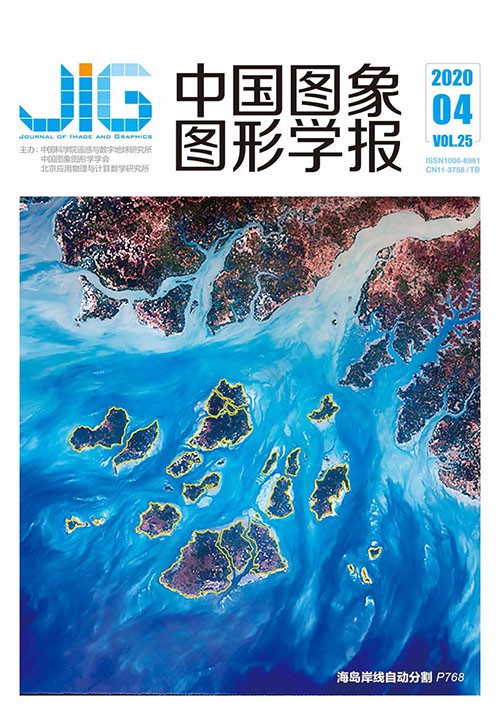
低秩和主动形状模型的肺区分割
摘 要
目的 肺区分割是肺癌计算机辅助诊断系统的首要步骤。主动形状模型(active shape model,ASM)能根据训练集获得肺区形状模型,再结合待分割肺区影像自身的局部特征,进行测试影像的分割。由于主成分分析(principal component analysis,PCA)仅能去除服从高斯分布的噪声,不能处理其他类型的噪声,所以当训练集含有非高斯类型的噪声样本时,采用基于PCA的ASM无法训练出正确的形状模型,使得肺区分割不能得到正确的结果。而低秩(low rank,LR)理论的鲁棒主成分分析(robust principal component analysis,RPCA)能去除各种类型的噪声,基于此,本文提出一种将RPCA与ASM相结合的方法。方法 首先对训练样本集标记点矩阵进行低秩分解,去除噪声样本对训练出的形状模型的影响。然后在ASM训练局部梯度模型时,用判断训练样本轮廓上的标记点曲率直方图的相似度来去除噪声样本。结果 在训练集含噪声样本时,将基于RPCA的ASM与传统ASM(即基于PCA的ASM)分别生成的形状模型进行对比,发现基于RPCA的ASM生成的形状模型与训练集无噪声样本时传统ASM生成的形状模型更相符。在训练集含噪声样本的情况下,基于RPCA的ASM方法分割EMPIRE10数据集中的22个肺影像,与金标准的重叠度为94.5%,而基于PCA的ASM方法分割准确率仅为69.5%。结论 实验结果表明,在训练样本集中有噪声样本的情况下,基于RPCA的ASM分割能得到比基于PCA的ASM更好的分割效果。
关键词
Lung segmentation by active shape model approach based on low rank theory
Sun Shenshen1, Tian Dan1, Wu Wei1, Kang Yan2, Zhao Hong2(1.Information and Engineering School, Shenyang University, Shenyang 110044, China;2.Sino-Dutch Biomedical and Information Engineering School, Northeastern University, Shenyang 110016, China) Abstract
Objective Computer-aided diagnosis of lung cancer is the automatic recognition of lung lesions in computed tomography (CT) images through a computer image processing technology. Given that lung lesions are located in the lung areas, the contours of lung areas should be automatically marked on lung images first. Thus, lung segmentation is the first step in the computer-aided diagnosis of lung cancer. Current segmentation methods for pulmonary parenchyma, including normal and pathological, can be divided into three categories according to visual appearance, location relationship of shape, and whether or not the method is a hybrid. Methods based on visual appearance mostly consider the lower gray values of lung areas instead of surrounding tissues. Therefore, a pathological lung (especially including interstitial lung disease) is segmented by a classifier on the basis of gray and texture features. These methods mainly introduce the anatomical relationship of the lungs with the heart, liver, spleen, and rib. Hybrid methods establishes shape models and evolves lung contours according to surface features. They can achieve good segmentation results without noise samples in training sets but does not consider the problem of noise samples in the training sets during the construction of training shape models. The active shape model (ASM) based on principal component analysis (PCA) is an outstanding method, which can only deal with Gaussian noise. ASM is a statistical deformation model and uses PCA to obtain the average shape and the allowable range of shape of a training sample set and then establishes a shape model. ASM establishes a local feature appearance model according to the training sample set. Finally, ASM evolves the contour of the test image on the basis of the local feature appearance and shape models. Robust PCA (RPCA) in low rank theory is robust to any kind of noise. In addition,the shapes of a training sample set have a low rank attribute because the anatomical shapes of the human lungs are roughly the same. Therefore, this study combined RPCA with ASM to solve the problem that the correct shape model cannot be obtained because of noise samples in training sets. Method First, a traditional method was used to segment the pulmonary region of training samples and generate lung boundary contours. The segmentation steps include extra-pulmonary region exclusion by iteration threshold and region growing segmentation methods, trachea elimination, internal cavity filling, liver elimination, and left and right lung separation. Second, we extracted 96 marker points on the left or right lung boundary contour. We assigned these marker points as x-coordinates and y-coordinates and placed them into a single matrix. Then, we aligned the lung boundary contours in the training sample set through the Procrustes analysis method. Third, we decomposed the matrix through the low rank theory into the low rank component and noise component matrices. We used the accelerated approximation gradient method to solve the decomposition and employed PCA to the low rank component matrix and obtained the eigenvalues and eigenvectors. They were used to construct the shape model, which is expressed as the average shape and deformation range. Then, we established a local feature appearance model by using gradient features and obtained a gradient-level appearance model that describes the typical image structure around each landmark from pixel profiles sampled (using linear interpolation) around each landmark perpendicular to the contour. Finally, ASM evolved the contour of the test image based on the local feature appearance and shape models. In the training of the local gradient model in ASM, the noise samples of the training set must be eliminated. In this study, the similarity of the curvature histograms of the marked points on the contours of the training samples was evaluated, and noise samples were removed. Result First, a training dataset was established. It consisted of 35 multi-slice spiral CT lung scan images collected from the First Affiliated Hospital of Guangzhou Medical University. Two scans included juxta-pleural tumor on the left side. The test dataset comprised 22 scans from EMPIRE 10 and is the gold standard for lung contours.The five scans included juxta-pleural tumor on the left side. Using the proposed method to segment the 22 lungs of EMPIRE10 database, we obtained the overlap rate with a gold standard of 94.5%. Meanwhile, the accuracy of ASM based on PCA was only 69.5%. The shape models generated by RPCA-based ASM and traditional ASM (i.e., PCA-based ASM) were compared when the training set contained noise samples. Notably, the shape model generated by ASM based on RPCA was consistent with the shape model generated by the traditional ASM when the training set was noiseless. Remarkably, RPCA eliminated the influence of the noise samples on the shape model. Adding PRCA to other lung parenchyma segmentation algorithms generated good results for training sets containing noise samples. The gray threshold method and ASM segmentation method based on RPCA were used to segment the same lung image with juxta-pleural tumor.Notably, the ASM segmentation method based on RPCA generated correct segmentation results in contrast to the gray threshold method. Conclusion The experimental results showed that a good segmentation result was obtained by the ASM based on RPCA when the noise sample was contained in the training sample set. When the pulmonary parenchyma was absent, some markers were updated to the transition region of the normal lung tissues and tumor rather than to the real lung border during searching.Thus, identifying abnormal markers first is necessary. A new abnormal marker identification method should be designed to provide different searching functions for normal and abnormal markers.
Keywords
low rank(LR) active shape model (ASM) robust principal component analysis (RPCA) lung segmentation noise samples
|



 中国图象图形学报 │ 京ICP备05080539号-4 │ 本系统由
中国图象图形学报 │ 京ICP备05080539号-4 │ 本系统由